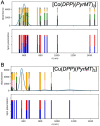Room-Temperature Spin-Dependent Transport in Metalloporphyrin-Based Supramolecular Wires
- PMID: 34726815
- PMCID: PMC9298358
- DOI: 10.1002/anie.202110515
Room-Temperature Spin-Dependent Transport in Metalloporphyrin-Based Supramolecular Wires
Abstract
Here we present room-temperature spin-dependent charge transport measurements in single-molecule junctions made of metalloporphyrin-based supramolecular assemblies. They display large conductance switching for magnetoresistance in a single-molecule junction. The magnetoresistance depends acutely on the probed electron pathway through the supramolecular wire: those involving the metal center showed marked magnetoresistance effects as opposed to those exclusively involving the porphyrin ring which present nearly complete absence of spin-dependent charge transport. The molecular junction magnetoresistance is highly anisotropic, being observable when the magnetization of the ferromagnetic junction electrode is oriented along the main molecular junction axis, and almost suppressed when it is perpendicular. The key ingredients for the above effect to manifest are the electronic structure of the paramagnetic metalloporphyrin, and the spinterface created at the molecule-electrode contact.
Keywords: density functional calculations; magnetoresistance; metalloporphyrins; single-molecule junctions; spinterface.
© 2021 The Authors. Angewandte Chemie International Edition published by Wiley-VCH GmbH.
Conflict of interest statement
The authors declare no conflict of interest.
Figures







References
-
- Sanvito S., Nat. Phys. 2010, 6, 562–564.
-
- Sanvito S., Chem. Soc. Rev. 2011, 40, 3336–3355. - PubMed
-
- Fusil S., Garcia V., Barthélémy A., Bibes M., Annu. Rev. Mater. Res. 2014, 44, 91–116.
-
- Hirohata A., Takanashi K., J. Phys. D 2014, 47, 193001.
-
- Sinova J., Valenzuela S. O., Wunderlich J., Back C. H., Jungwirth T., Rev. Mod. Phys. 2015, 87, 1213–1260.
Grants and funding
- PGC2018-093863-B-C21/Ministerio de Ciencia, Innovación y Universidades
- PID2019-108794GB-100/Ministerio de Ciencia, Innovación y Universidades
- MDM-2017-0767/Ministerio de Ciencia, Innovación y Universidades
- CEX2019-000917-S/Ministerio de Ciencia, Innovación y Universidades
- RYC-2017-22910/Ministerio de Ciencia, Innovación y Universidades
LinkOut - more resources
Full Text Sources

